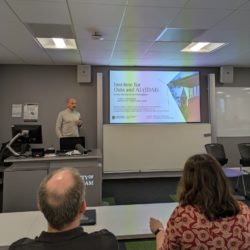Over the three days of 24-26 June, we welcomed 90 undergraduate and postgraduate taught students to #BEARChallenge2025. In an attempt to meet demand for places, this year we expanded to allow 15 teams but demand also rose at a pace, with 31 teams registering their interest! It is great to see the level of interest … Continue reading “BEAR Challenge 2025”
Category: High Performance Computing
What makes things go BOOM! – from vibrations to detonation
In this case study we talk to Jakob Hein-Paar, a PhD student in the Michalchuk Group, Chemistry, who looked into the effects of phonons on the reactivity of energetic materials. My research deals with vibrational metallization of metal azides, a group of energetic materials or explosives, investigating energy transfer within their crystal structures. As “vibrational” implies, … Continue reading “What makes things go BOOM! – from vibrations to detonation”
Planned work to improve resilience of the Research Data Store
Users of the Research Data Store (RDS) may have noticed intermittent performance issues affecting storage recently, which has been causing some disruption to users. This work is a necessary precursor to a major program of work in which we will replace, expand and enhance, the RDS service. Phase 1 Between now and summer 2025 we … Continue reading “Planned work to improve resilience of the Research Data Store”
‘Data and AI for researchers’ at the University’s first Data Conference
On Wednesday 26 February, the University’s inaugural Data Conference was held. With a series of talks and interactive sessions covering advice and tips on handling data, and a focus on building a community of data professionals, we ran a session in collaboration with the Institute for Data and AI entitled ‘Research and AI for researchers’. … Continue reading “‘Data and AI for researchers’ at the University’s first Data Conference”
Elucidating the Pathways for Human Tooth Enamel Mineralisation
In this case study, we hear from Mahdi Tavakol (based at University of Oxford, and visiting researcher), who has been utilising BEAR to study tooth mineralisation and demineralisation. My name is Mahdi Tavakol. I am a computational scientist in the Department of Engineering Science at the University of Oxford and a visiting researcher and collaborator … Continue reading “Elucidating the Pathways for Human Tooth Enamel Mineralisation”
Baskerville multi-GPU RSE call
Many new and upcoming HPC systems provide computing power through GPUs. Relatively little research software uses such hardware and less still can fully exploit multiple GPUs simultaneously. The Research Software Group (RSG) is in a position to offer time-limited support to researchers at the University of Birmingham with research software that currently runs on GPUs … Continue reading “Baskerville multi-GPU RSE call”
Training accurate Machine Learnt Interatomic Potentials (MLIPs) for High Entropy Alloys (HEAs)
In this case study, we hear from Joseph Arnold (based at the School of Metallurgy and Materials), who has been utilising BEAR for developing machine learning-based interatomic potential’s (MLIP). I am a postdoctoral research fellow in the Gurrutxaga-Lerma research group within the School of Metallurgy and Materials, here at the University of Birmingham. My research … Continue reading “Training accurate Machine Learnt Interatomic Potentials (MLIPs) for High Entropy Alloys (HEAs)”
BEAR users feature in awards for game-changing impact
We were very pleased to hear some familiar names mentioned in the recent ‘Awards for Game-Changing Impact‘. We would like to congratulate all the award winners but in this blog post, we are going to focus on those winners who make use of BEAR services to enable their research. The various BEAR services provided by … Continue reading “BEAR users feature in awards for game-changing impact”
Investigating the brain with BEAR
In this case study, we hear from Brandon Ingram (based at the School of Psychology), who has been utilising BEAR to deepen their understanding of the mechanisms our brains employ to interpret visual stimuli. My research focuses on integrating electroencephalography (EEG) and functional magnetic resonance imaging (fMRI) to gain a more comprehensive understanding of how … Continue reading “Investigating the brain with BEAR”
Using computational and laboratory research to unravel genome plasticity in plants
In this case study we hear from Katie Jeynes-Cupper, a PhD student in Biosciences, who has been using BlueBEAR to unravel genome plasticity in plants. She was the winner of the best presentation at our recent BEAR Conference 2024. From food security to biofuel production, the demand for plant-derived products is growing exponentially, in parallel … Continue reading “Using computational and laboratory research to unravel genome plasticity in plants”










